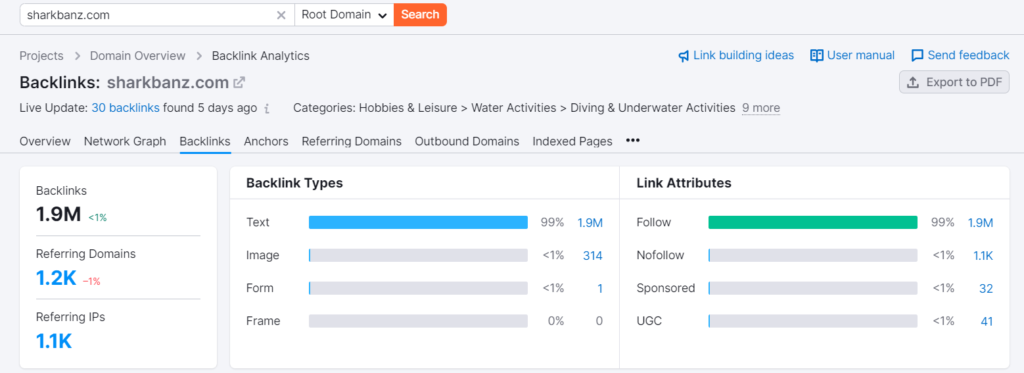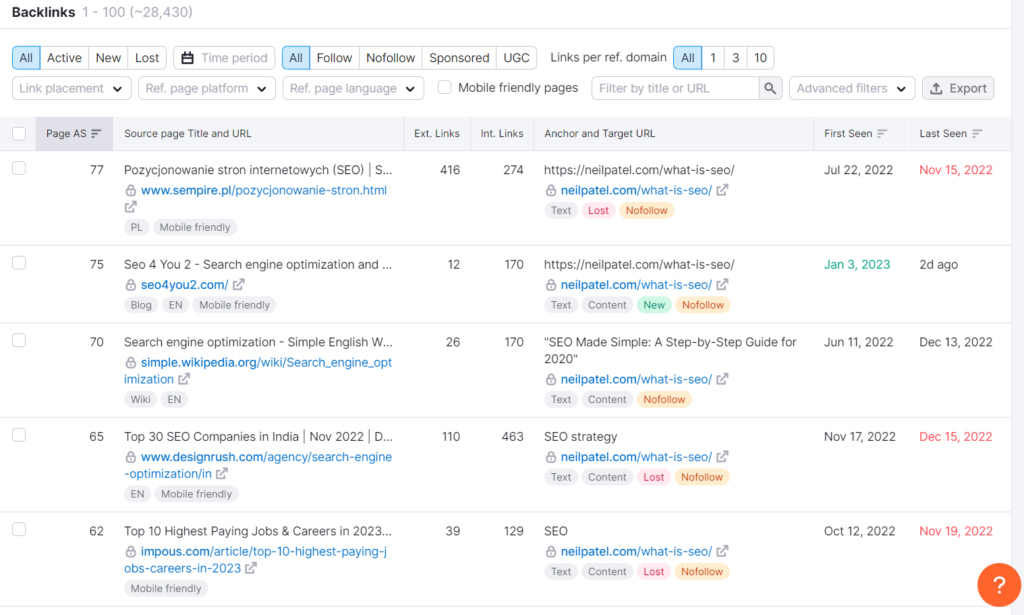Building backlinks for an eCommerce site can be one of the most daunting tasks for online business owners.
There are many methods for creating eCommerce backlinks, but not all of them will drive traffic to your site, or even be effective.
This article will outline four proven methods for creating backlinks for your eCommerce site that will help you increase traffic and boost your search engine rankings. But first, we will quickly review what eCommerce backlinks are and why they are so beneficial for SEO.
Table of Contents
What Are eCommerce Backlinks?
eCommerce backlinks are links from other websites that direct customers to an eCommerce website. These links can be from a variety of sources, such as other websites, search engines, social media sites, forums, and blogs. They are important because they help to increase its visibility and improve its search engine rankings.
In addition, backlinks can lead to increased customer loyalty and sales. However, these are just a few of the benefits that high-quality backlinks bring to an eCommerce website.
Let’s take a closer look at what having an eCommerce backlink strategy can do for your store.
Benefits of eCommerce Backlinks
We’re not going to bore you with the specifics of what PageRank is and how it works, so let’s talk about factual business benefits, as opposed to just SEO.
Bonus Content: How to Get Your Shopify Store to Rank #1 on Google
1. Increased Authority
Authority is a measure of how trustworthy or reliable a website or domain is. It is based on the strength of the website’s backlinks, content, and other factors. It is often used to determine which websites get the highest rankings in search engine results. And backlinks are an important element in boosting a website’s authority.
By getting other websites to link to your site, it shows Google that your store is trustworthy and reliable. This in turn can help you get higher rankings in search engine results, which can lead to more traffic and increased reach to new potential customers.
Additionally, your backlink strategy will help drive brand awareness and credibility. This can help you establish yourself as the authority in your industry, as well as increase your website’s visibility and reach.
Prop Tip: Backlinks are just one way to increase your website’s authority. You should also focus on creating high-quality content, optimizing for SEO, and using social media to build relationships and reach new audiences. To improve the results from your social media efforts, you can use social media management tools like Sprout Social or Sprout Social alternatives.
2. Increased Referral Traffic
Referral traffic is the number of visitors to a website or webpage that arrive at the site by clicking on a link from another website or page, as opposed to organic traffic which comes from Google and other search engines. It is an important metric, as it allows you to measure how successful your referral campaigns are.
In addition, referral traffic is more targeted than organic traffic because it is more likely to be from a specific source. For example, if a website gets a lot of referral traffic from a particular blog, then the website can target that blog’s audience with content that is tailored to them. This is a more effective way of reaching potential customers than relying just on organic search results.
Referral traffic can be tracked more easily than organic traffic.
Why?
While organic traffic is the collection of all clicks coming from search engine results pages, Google Analytics breaks down referral traffic by specific domains. This makes it easier to measure the success of campaigns as well as to identify which sources are driving the most traffic to the website. Such information can then be used to optimize future campaigns and ensure that the website is targeting the right people.
Bonus Content: The Biggest Analytics Lies and How to Spot Them
3. Increased Brand Awareness
eCommerce links can play a major role in improving an eCommerce site’s brand awareness.
Linking to other websites and content can help build relationships with other businesses, customers, and influencers. When other websites and content link to an eCommerce site, it can help increase its visibility and credibility.
This visibility and credibility can lead to more people becoming aware of the brand and even visiting the website.
How? By creating linkable assets in the form of blog posts, infographics, etc., on your store.
This, in turn, increases the number of clicks from informational keywords (people just trying to learn about something). Over time, this will help you establish thought leadership in your niche, which translates into brand awareness. There is content creation software that can help you create more linkable content, or you can DIY it. The guide below will help you do just that.
Additionally, link building itself involves creating relationships with other websites, content creators, store brands, and influencers who can link to the brand’s website. This can help bring in more traffic and create more exposure for the brand as your brand is linked to more organically.
4. Improved Customer Trust
eCommerce backlinks are a powerful tool for improving customer trust in an eCommerce site. Take, for example, Sharkbanz. It’s an extremely niche product — a band that you wear on your arm or leg to deter sharks and rays in the open ocean. Sharkbanz’s revenue is over $5 million with nothing but positive reviews. But if that’s not impressive enough, they have 1.9 million backlinks from over 1,000 unique referring domains.
Here’s a screenshot showing their backlinks from SemRush tool.
Coincidence? We think not.
By including backlinks from other reputable websites, eCommerce sites can demonstrate to customers that their site is trustworthy and reliable.
5. Improved Conversion Rates
All of the points above lead to potentially increased conversion rates, with more and more trusting people coming to your resource from other, respected websites. It’s simple math — the higher your website ranks on search engine result pages, the more people are exposed to your brand and the more they will come to your site from an organic search.
Additionally, the more links you have on other resources, the more referral traffic you will start to receive. And the more shoppers you have on your store, the bigger the chance of them buying something.
What Do You Need to Start Link Building?
Link building is a time- and resource-intensive process, so you need to be aware of what you need to get started with it. There are two main elements you should consider:
- Good content
- Outreach strategies
Let’s take a closer look at each.
1. Good content
Content not only helps you build trust with your target audience but also acts as fuel for your other marketing techniques.
That’s why content is so important for your link building strategy. Few people will link to your product pages for absolutely free, so you need to invest a considerable amount of time and effort into building a robust blog that covers a wide range of topics.
Here are some tips for building up your eCommerce blog content:
- Research the latest industry trends and news. Identify topics that are relevant and interesting to your target audience.
- Monitor customer conversations on social media. Keep an eye on what your customers are talking about to help you find ideas for blog topics.
- Ask customers for feedback. Ask customers for their feedback and opinions on topics related to your eCommerce business. This can provide you with fresh ideas for blog posts.
- Look at competitor blogs. Take a look at what your competitors are blogging about. You can use their topics as inspiration for your own blog.
- Use data to inform content. Analyze your website’s data to find out what content is working and which topics your readers are responding to.
- Leverage customer stories. Share customer stories and experiences on your blog. This can help build trust with your readers and showcase the value of your products or services.
- Utilize visuals and videos. Incorporate visuals and product videos into your blog posts to make them more engaging.
- Offer advice and solutions. Provide readers with advice and solutions to common problems related to your eCommerce business.
Bonus Content: 6 Tips to Create a Scalable Content Marketing Campaign
And a blog not only provides you with content to build links to but allows you to cover a range of informative keywords that your audience is searching for online. You can read more about using your blog for SEO, here.
2. Outreach Strategies
Everything about link building takes time — from finding prospects to personalizing pitches to actually managing conversations.
Why?
Link building only kicks in when done consistently over a long period of time (several months or even years), so we suggest getting a dedicated team member to help you manage the process efficiently. Or at least investing in the right tools, which can help with tasks such as:
- Checking all of a page’s backlinks
- Preparing a mass email outreach campaign, along with finding the contact emails of hundreds of recipients
Therefore, using software such as Respona and Ahrefs for these tasks can be a huge help. Respona, for instance, is a tool for link-building outreach, which automates each step — from finding prospects, to finding their contact information, and personalizing pitches. While Ahrefs, on the other hand, enables you to track your link-building efforts, as well as reveal your competitors’ backlink profiles.
4 Ways to Build eCommerce Backlinks
Now, let’s take a look at the exact link building strategies you can use to promote your eCommerce store.
Strategy #1: Get Featured on Listicles
Being featured in list-style articles (top 5, 10, 15, etc.) is an excellent way to market your business or content. These articles are highly favored by readers and search engines, which is why they are so popular across the web.
Being featured in list-style articles (top 5, 10, 15, etc.) is an excellent way to market your business or content. These articles are highly favored by readers and search engines, which is why they are so popular across the web.
To use this strategy successfully, you should seek out listicles that fit your niche and reach out to the authors, asking if they would include your business/article. Finding these is pretty easy — just type in:
intitle:“best/top + your target keyword”
Once you have your list of websites you’d like to reach out to for placements, feel free to grab the following email template for inspiration on your own outreach.
Backlink Outreach Template
“Subject: Missed one
Hi {first_name},
It seems like you missed [company name] in your post on [target keyword1] 🙁
[Unique aspects of your company]
[Incentive]
How does that sound?
[Signature]”
Here’s an example of a brand, Nuleaf, who has been added to review lists to build backlinks.
[Source: Observer]
Strategy #2: “Steal” Potential Backlinks from Competitors
The objective of this backlinks technique is to acquire backlinks from articles that are associated with the pages your rivals are already ranking for. Essentially, you will be finding links to other people’s content and asking them to link to you instead.
For instance, if we have published a blog post about content distribution, we might look for websites that have connected to guides about content distribution from our opponents.
The best way to find these is with the help of backlink monitoring software such as Ahrefs or Semrush. With these tools you can find competing content, paste its URL into either tool’s backlink monitoring feature, and export its results. Like what we did with the Semrush tool here:
Once you have your prospect sheet, clean it up to remove any low-quality opportunities. You can then either manually, or with software, prepare your outreach sequence, find contact emails, and, of course, personalize your pitches. Here’s a template you can use.
Backlink Outreach Template
“Subject: Updated guide on [target keyword]
Hi {first_name},
You referenced an older post on [target keyword] in your article.
We just released a brand-new guide on the topic that would make a better fit.
[Content description]
[Incentive]
How does that sound?
[Signature]”
Strategy #3: Targeting Existing Anchor Text
Next, you want to try reaching out to third-party sites to add your targets to editing text in their content.
Generally, this process is uncomplicated. You would first search for articles that have mentioned your target keyword in their content, and then ask them to link to your resource from that specific anchor text. The trick, though, is finding non-competing content that targets a different keyword as its focus.
For instance, if you have a how-to guide on your blog around, say, gift buying, you want to locate other blog posts that have briefly touched on the topic. You can then approach the site editor or manager with the suggested link for that relevant anchor text.
To get more granular with your search results, you can use advanced search operators in Google — which can be used for more refined searches. For instance, to find related content you would use the “intitle:” and “intext:” search operators to define pages that mention certain keywords in the titles and bodies.
Tip: Not familiar with advanced search operator codes? Here’s a great summary of the most important shortcuts from Moz.
[Source: Moz]
For example, let’s search for websites that have mentioned “fashion tips” but aren’t targeting this keyword as their main one, making them non-competitive and more likely to actually link to us. Here’s the shortcode we may use.
inurl:blog -intitle:”fashion tips” intext:”fashion tips”
This tells Google to only search for pages that are part of a blog that mentions “fashion tips” in the content, but not in the title.
Once you have narrowed down your list, you will want to reach out. Here’s a template you can use.
Backlink Outreach Template
“Subject: Your [target keyword1] article
Hi {first_name},
You briefly talked about [target keyword1] in your article.
We just released a comprehensive guide that would make a perfect addition.
[Content description]
[Incentive]
How does that sound?
[Signature]”
Strategy #4: Invest in Guest Posting
Guest posting is a popular link building technique that offers multiple high-quality backlinks from a single post. By creating and posting content on third-party, good-quality sites, you can increase your good-quality backlinks while also building authority within your niche.
One thing you should know about guest posting is that most resources only allow one link back to your own website in the content. And even if you could add more, multiple links from the same page don’t hold nearly as much value as backlinks from different domains.
Where guest posting truly shines is when you use them as a way to supplement your other link-building efforts and use backlink partners.
Pro Tip: Find Backlinking Partners
To help increase your links for each guest post, you will want to partner with a few other store brands. This way, you could include your partner’s backlinks into third-party websites (in your guest post content) instead of yours.
Your partner, in turn, will place links for yours on other sites, which means you’ve gotten more than one link in return for one guest post.
To find guest post opportunities, search for websites that interest your audiences — what niche-related content are they reading? Then you will want to narrow down your list by seeing if they accept guest posts.
When pitching guest posts, you can use the template highlighted below.
Guest Post Outreach Template
“Subject: Suggesting content ideas
Hi {first_name},
Would it be ok to send over a few topic ideas for your blog?
I’d love to do keyword research and find what terms your competitors are ranking for, but [website_name] isn’t.
No strings attached if you didn’t like the topics.
P.S. Here’s an example of a piece I’ve written recently: [example content URL]
[Signature]”
Wrap Up
In conclusion, building eCommerce backlinks is a great way to increase your website’s visibility and grow your business — while also establishing you as the ultimate authority in your niche.
With the right strategies, you can easily and effectively increase your website’s search engine ranking and generate more traffic. Let’s recap those strategies:
4 Ways to Build eCommerce Backlinks
By leveraging content marketing, guest blogging, customer experience management, directory submissions, and influencer marketing, you can create meaningful and valuable backlinks that will help your eCommerce website get noticed and attract more customers.

Managing brand partnerships at Respona, Vlad Orlov is a passionate writer and link builder. Having started writing articles at the age of 13, their once past-time hobby developed into a central piece of their professional life.
Recommended articles
 Facebook Ads for eCommerce: 16 Strategies, Examples & Tips
Facebook Ads for eCommerce: 16 Strategies, Examples & Tips
 How to Build a Winning eCommerce Ads Strategy
How to Build a Winning eCommerce Ads Strategy
 Google Ads for eCommerce: Everything You Need to Know
Google Ads for eCommerce: Everything You Need to Know
 10X Your Traffic with PPC Management Software
10X Your Traffic with PPC Management Software
Comments
Powered by Facebook Comments









